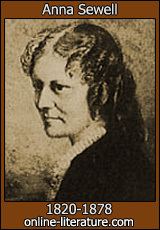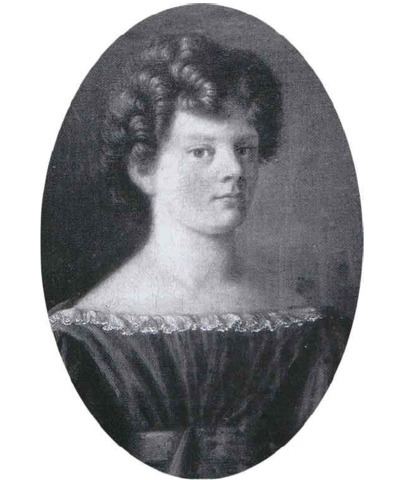Name Anna Sewell Nationality English | Period 19th century Movies Black Beauty | |
 | ||
Parents Isaac Phillip Sewell, Mary Wright Sewell Books Black Beauty, Black Beauty's Early Day, Black Beauty - Young Fo, Black Beauty - Young Fo, Black Beauty Book and Similar People Frances Hodgson Burnett, Kenneth Grahame, Johanna Spyri, Lewis Carroll, E Nesbit | ||
Black beauty by anna sewell full audiobook greatest audio books
Anna Sewell (; 30 March 1820 – 25 April 1878) was an English novelist. She is best known as the author of the 1877 novel Black Beauty, one of the top ten best selling novels for children ever written.
Contents
- Black beauty by anna sewell full audiobook greatest audio books
- Black beauty black beauty by anna sewell an autobiography told by a horse full audiobook
- Early life
- Adult life
- Memorials and monuments
- References

Black beauty black beauty by anna sewell an autobiography told by a horse full audiobook
Early life
Sewell was born on 30 March 1820 in Great Yarmouth, Norfolk, into a devoutly Quaker family. Her father was Isaac Phillip Sewell (1793–1879), and her mother, Mary Wright Sewell (1798–1884), was a successful author of children's books. She had one sibling, a younger brother named Philip. The children were largely educated at home by their mother due to a lack of money for schooling.
In 1822, Isaac's business, a small shop, failed and the family moved to Dalston, London. Life was difficult for the family, and Isaac and Mary frequently sent Philip and Anna to stay with Mary's parents in Buxton.
In 1824, Sewell slipped at home and severely injured her ankle. For the rest of her life she could not stand without a crutch or walk for any length of time. For greater mobility, she frequently used horse-drawn carriages, which contributed to her love of horses and concern for the humane treatment of animals. In 1832, when she was twelve, the family moved to Stoke Newington and Sewell attended school for the first time.
Adult life
In 1836, Sewell's father took a job in Brighton, in the hope that the climate there would help to cure her. At about the same time, both Sewell and her mother left the Society of Friends to join the Church of England, though both remained active in evangelical circles. Her mother expressed her religious faith most noticeably by authoring a series of evangelical children's books, which Sewell helped to edit, though all the Sewells, and Mary Sewell's family, the Wrights, engaged in many other good works. Sewell assisted her mother, for example, to establish a working men's club, and worked with her on temperance and abolitionist campaigns.
In 1845, the family moved to Lancing, and Sewell's health began to deteriorate. She travelled to Europe the following year to seek treatments. On her return, the family continued to relocate – to Wick in 1858, and to Bath in 1864.
In 1866, Philip's wife died, leaving him with seven young children to care for, and the following year the Sewells moved to Old Catton, a village outside the city of Norwich in Norfolk, to support him. While living there, Sewell wrote the manuscript of Black Beauty – in the period between 1871 and 1877. During this time her health was declining; she was often so weak that she was confined to her bed and writing was a challenge. She dictated the text to her mother and from 1876 began to write on slips of paper which her mother then transcribed.
Although the book is now considered a children's classic, Sewell originally wrote it for those who worked with horses. She said "a special aim [was] to induce kindness, sympathy, and an understanding treatment of horses". In many respects the book can be read as a guide to horse husbandry, stable management and humane training practices for colts. It is considered to have had an effect on reducing cruelty to horses; for example, the use of bearing reins, which are particularly painful for a horse, was one of the practices highlighted in the novel, and in the years after the book's release the reins became less popular and fell out of favour.
Sewell sold the novel to London publisher Jarrolds on 24 November 1877, when she was 57 years old. She received a single payment of ₤40 and the book was published the same year.
Sewell was in extreme pain and completely bedridden for the folllowing months, and she died on 25 April 1878 of hepatitis or tuberculosis. She was buried on 30 April 1878 in the Quaker burial-ground at Lammas near Buxton, Norfolk, not far from Norwich.
Memorials and monuments
Sewell's birthplace in Church Plain, Great Yarmouth has been the home to a museum and a tea shop. The house in Old Catton where she wrote Black Beauty is now known as Anna Sewell House.
There is an Anna Sewell memorial fountain and horse trough outside the public library in Ansonia, Connecticut, in the United States of America. It was donated by Caroline Phelps Stokes, a philanthropist known for her work supporting animal welfare, in 1892.
A memorial fountain to Sewell is located at the junction of Constitution Hill and St. Clement's Hill in Norwich, which also marks the entrance to Sewell Park. The fountain was placed in 1917 by Sewell's niece Ada Sewell.
On 1 September 1984 the graveyard at Lammas was bulldozed by contractors under the direction of Mrs Wendy Forsey without prior warning or permission. Tombstones, graves and cypress trees were removed and dumped at the edge of the burial ground. The act was condemned by locals and Council Chairman John Perkins who said "I know the land belongs to a private person but I would almost say it was as bad as vandalism. I know Quaker ground is not consecrated, but for anybody to just pull down gravestones of any Quaker, whether it's Anna Sewell or not, well, I think it's despicable". The gravestones of Anna, her parents and maternal grandparents were subsequently placed in a flint-and-brick wall outside the old Lammas Quaker meeting house.
